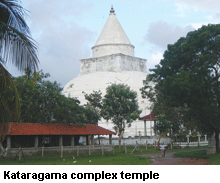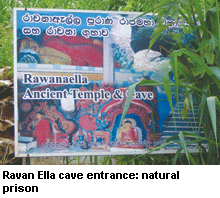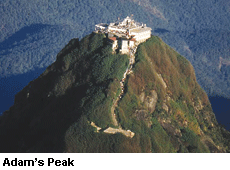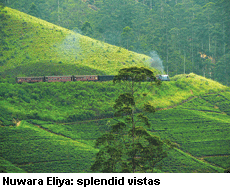Having already explored central and northern sri lanka where many of the better known tourist attractions are located on a previous visit to the country, Yoginder Sikand decided to spend a short vacation in southern sri lanka which was unfamiliar territory.
.gif) The 35 km bus drive from the airport to Pettah, the bustling commercial district in the heart of Colombo, the national capital of the island republic of Sri Lanka (pop. 20 million), took an agonising two hours. The early morning rush hour traffic crawled along the highway in a lazy, serpentine queue. The little that I managed to see of Colombo as the bus plunged deeper into the city, helped me to decide that I didn’t need to explore it.
The 35 km bus drive from the airport to Pettah, the bustling commercial district in the heart of Colombo, the national capital of the island republic of Sri Lanka (pop. 20 million), took an agonising two hours. The early morning rush hour traffic crawled along the highway in a lazy, serpentine queue. The little that I managed to see of Colombo as the bus plunged deeper into the city, helped me to decide that I didn’t need to explore it.
Therefore when we got to the main bus terminal at Pettah, from where buses head in all directions to different parts of Sri Lanka, I took the first one out of Colombo. It was heading for the seaside town of Galle, almost at the tip of the tear-shaped island. Having already explored central and northern Sri Lanka where many of the better known tourist attractions are located, on a previous visit to the country, I decided to spend my short vacation of seven days in southern Sri Lanka which was unfamiliar territory.
The bus pulled out of the urban sprawl of Colombo until it began to burn rubber on the highway leading to Galle, a four hour journey to the south. The highway ran parallel to the sparkling turquoise waters of the Indian Ocean, skirted by expanses of spotless sand, and garlanded with swaying coconut palms. However, almost the entire coastline, till we got to Galle, was experiencing feverish construction activity. Almost every available bit of beach has been gobbled up by pricey hotels, catering mainly to the 600,000 sun-thirsty Western tourists who flock to Sri Lanka every year. Mass tourism means money for the cash-strapped island, but it is overwhelming its famed natural beauty, as the ugly jumble of hotels indicated.
Galle (pop.100,000) was just the sort of laid-back, quaint town in which I needed to unwind. It is small enough to cover on foot, and sans the flurry and clatter of Colombo, with much to offer visitors. According to some historians, Galle emerged as the centre of the spice trade more than three millennia ago, a hub of commercial activity attracting traders from as far afield as Persia, Arabia, Greece, Rome, China, present-day Indonesia and, of course, India. The Portuguese were the first Europ-eans to settle here in the 16th century, followed by the Dutch. The British took over in the late 18th century.
Reminders of galle’s colonial past are scattered about the town. Its Dutch-built fortress, said to be Asia’s largest, juts into the sea, surrounded by formidable moss-laden walls. Within the sprawling complex are hundreds of ancient buildings — a neatly white-washed church, mosque, a towering lighthouse, Dutch tomb-complexes and clusters of bungalows located behind low comp-ound walls topped by flowering creepers, which, though centuries’ old, are still meticulously maintained. Most of the inhabitants are Muslims, locally known as Moors, and are believed to be descendants of Arab traders.
 After doing a quick round of the sites in town that my guide book recomm-ended, and spending the night at a friendly lodge, I headed next morning to the town of Tissa to the east, along a road that hugged the sea. There was little to see in Tissa except for a massive dagoba, a stupa-shaped Buddhist shrine, which, according to local lore (although this claim is challeged by some historians) marks the site where the Buddha stayed on one of his reported visits to Sri Lanka. It is revered in legend as the dagoba which contains some sacred relics of the Buddha — his left tooth and a fragment of his bones. The friendly head of the local Buddhist monastery, a bhikshu (mendicant) with a doctorate from Benaras Hindu University, showed me some ancient palm leaf manuscripts in possession of the shrine before I headed back and boarded a bus to the neighbouring town of Kataragama, one of Sri Lanka’s most popular pilgrimage centres, named after the eponymous divinity.
After doing a quick round of the sites in town that my guide book recomm-ended, and spending the night at a friendly lodge, I headed next morning to the town of Tissa to the east, along a road that hugged the sea. There was little to see in Tissa except for a massive dagoba, a stupa-shaped Buddhist shrine, which, according to local lore (although this claim is challeged by some historians) marks the site where the Buddha stayed on one of his reported visits to Sri Lanka. It is revered in legend as the dagoba which contains some sacred relics of the Buddha — his left tooth and a fragment of his bones. The friendly head of the local Buddhist monastery, a bhikshu (mendicant) with a doctorate from Benaras Hindu University, showed me some ancient palm leaf manuscripts in possession of the shrine before I headed back and boarded a bus to the neighbouring town of Kataragama, one of Sri Lanka’s most popular pilgrimage centres, named after the eponymous divinity.
The decades-long civil war in Sri Lanka between Buddhist Sinhalas and Hindu Tamils has taken a heavy toll on inter-community relations in this once idyllic island. Yet the enormous popularity of the cult of Kataragama among Sinhalas and Tamils in common indicates the bond between the two communities, formed over centuries through shared ritual spaces. For Tamils, Kataragama is the Dravidian god Murugan, whom Sinhala Buddhists venerate as bodhisattva, or one on the way to Buddha-hood. Strictly speaking, Buddhism doesn’t acknowledge divin-ities who intervene in people’s lives and therefore need to be appeased, but millions of Sinhalese revere Kataragama as a powerful divine force. The vast pilgrimage complex of Kataragama consists of numerous shrines encrusted with statues of fierce looking Hindu deities, a supremely serene Buddha, and a long-haired Kataragama astride a peacock.
The town was packed with pilgrims when I arrived early in the evening. Orderly and silent, the pilgrims whose number exceeded 10,000, walked in neat rows towards the temple, carrying little cane baskets containing offerings of fruits, coconuts, lily-buds and multi-coloured garlands. Outside the main temple, pilgrims smeared their foreheads with coloured paste, drank what they believed to be holy water, and crowded around a sadhu with tangled hair who wielded a trident in his hand and danced wildly to throbbing drums. A short walk from the temple, another imposing Buddhist stupa attracted streams of reverent devotees dressed in spotless white, who placed votive offerings of flowers circling its base, humming mantras.
 The next morning I headed northwards to Ella. The countryside is luxuriantly green, and the forest grew thicker as we climbed upwards into Sri Lanka’s famed Central Highlands — rows upon rows of rolling hills. Ella, a small settlement of just a couple of dozen houses, offered little sightseeing but served as a base point to trek to Ravan Ella, an hour’s hike up into the hills, crowned by an ancient Buddhist temple. From there it was yet another hour’s climb to an enormous cave deep inside a dense forest. Local legend says that in the lofty seclusion of this cave, Ravana, lord of Lanka, had kept Sita (of the Ramayana) captive.
The next morning I headed northwards to Ella. The countryside is luxuriantly green, and the forest grew thicker as we climbed upwards into Sri Lanka’s famed Central Highlands — rows upon rows of rolling hills. Ella, a small settlement of just a couple of dozen houses, offered little sightseeing but served as a base point to trek to Ravan Ella, an hour’s hike up into the hills, crowned by an ancient Buddhist temple. From there it was yet another hour’s climb to an enormous cave deep inside a dense forest. Local legend says that in the lofty seclusion of this cave, Ravana, lord of Lanka, had kept Sita (of the Ramayana) captive.
Certainly the scenic location of the cave seems an apt natural prison, evoking a poetic imagery in keeping with the legend of Sita. But the eerie and deserted cave stank of bird droppings, and I could barely make my way out in the enveloping darkness. When I finally crawled out and headed down a slippery path, I was obliged to grab trunk-like roots for support, as a thick blanket of fog from the surrounding hills shrouded the forest. And through the dense fog a gong sounded, signaling evening meditation at a nearby monastery.
 From Ella I chugged up in a mountain train to the town of Nuwara Eliya (pop. 742,000), Sri Lanka’s famous hill station set in tea growing country. The delightful ride offered splendid vistas of soaring peaks in the distance, hill slopes carpeted with tea plantations and interspersed with little villages perched in narrow valleys, along gurgling brooks and thickets of fruit trees.
From Ella I chugged up in a mountain train to the town of Nuwara Eliya (pop. 742,000), Sri Lanka’s famous hill station set in tea growing country. The delightful ride offered splendid vistas of soaring peaks in the distance, hill slopes carpeted with tea plantations and interspersed with little villages perched in narrow valleys, along gurgling brooks and thickets of fruit trees.
Fathoms above in awesome majesty, stood the 2,243-metre (7,358 ft) Adam’s Peak, a cone-shaped mountain sacred to Buddhists, Hindus, Christians and Muslims alike. Adam’s Peak houses the sri pada, a sacred footprint, which Buddhists believe to be of the Buddha, Hindus of Shiva, and Muslims and Christians of Adam, the father of all mankind who, it is believed, lived with Eve in the Garden of Eden in this very part of Sri Lanka. Trekkers and pilgrims routinely scale the peak.
As the epicentre of Sri Lanka’s thriving tea industry, Nuwara Eliya is a busy commercial town, but it is also popular with vacationers, with its numerous parks, trekking trails and graceful colonial buildings. A large proportion of the town’s residents are ‘Indian Tamils’, descendants of impov-erished, low caste labourers imported into Sri Lanka by the British to work their tea gardens. They are distinct from ‘Jaffna Tamils’, resident in northern Sri Lanka for centuries. Unlike the latter, the Indian Tamils seem content with peaceful co-existence with the indigenous Sinhala majority. They are not ardent supporters of the Tamil Eelam, a separate Tamil state in Sri Lanka and cause celebre, which prompted the recently concluded two-decades long civil war in this charming island republic.
 After days of surviving on hoppers — rotis and vegetables finely chopped into bits and garnished with spices — staple Sri Lankan street food, I feasted in a Tamil restaurant and took a bus to the nearby settlement of Sita Eliya. A Tamil-style temple, built on a brookside, marked the spot of the Ashoka Vatika, the garden where, so goes the legend, Sita was discovered by Hanuman.
After days of surviving on hoppers — rotis and vegetables finely chopped into bits and garnished with spices — staple Sri Lankan street food, I feasted in a Tamil restaurant and took a bus to the nearby settlement of Sita Eliya. A Tamil-style temple, built on a brookside, marked the spot of the Ashoka Vatika, the garden where, so goes the legend, Sita was discovered by Hanuman.
My second Sri Lankan sojourn was now at an end. I boarded a bus for a six-hour drive back, down winding roads over thickly-clad hills, past little hamlets and placid Buddhist monas-teries till I found myself back in the bustle of Pettah, the heart of Colombo, which I had fled days ago. Staying in roadside lodges, cheap but remarkably comfortable, and getting about on Sri Lanka’s enviably efficient public transport system, it had been a relatively inexpensive but rewarding vacation. I hope to return soon to lovely Serendip.